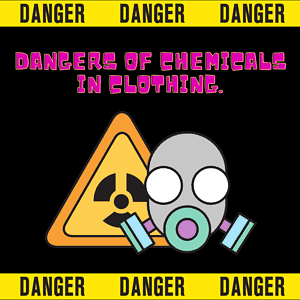Dangers of chemicals in clothing.
Chemicals used in clothing can pose various risks to human health and the environment. Here are some key dangers associated with chemicals in clothing:
Skin Irritation: Certain chemicals, such as formaldehyde, azo dyes, and flame retardants, can cause skin irritation, redness, itching, and allergic reactions when they come into contact with the skin.
Allergies and Sensitivities: Many chemicals used in clothing, including dyes, resins, and finishing agents, can trigger allergies and sensitivities in individuals with pre-existing conditions or those who are particularly susceptible.
Toxicity: Some chemicals used in clothing production, such as heavy metals (lead, cadmium, mercury) and phthalates, can be toxic and harmful if absorbed through the skin or ingested.
Environmental Pollution: The production and disposal of chemically treated clothing can contribute to environmental pollution. Chemical dyes and finishes may be released into water bodies during manufacturing, potentially harming aquatic ecosystems.
Occupational Hazards: The workers involved in textile manufacturing, particularly in developing countries with less stringent regulations, may be exposed to harmful chemicals during production processes, leading to health risks for the workers.
To mitigate these dangers, it is important to advocate for safer manufacturing practices, promote transparency in the textile industry, and choose clothing made from organic or eco-friendly materials that are certified to meet specific standards, such as the Global Organic Textile Standard (GOTS) or OEKO-TEX Standard 100.

Some examples of chemicals in clothing.
Here are some examples of chemicals commonly used in clothing production:
Formaldehyde: Often used in fabric finishes to prevent wrinkling and increase durability, formaldehyde can cause skin irritation, respiratory problems, and allergic reactions.
Azo dyes: A class of synthetic dyes commonly used in textiles, azo dyes can release aromatic amines, some of which are known to be carcinogenic or have toxic effects on the reproductive system.
Phthalates: These chemicals are used as plasticizers in clothing to increase flexibility and durability. Phthalates have been linked to hormonal disruptions and adverse effects on reproductive health.
Flame retardants: Added to clothing to reduce flammability, flame retardants such as polybrominated diphenyl ethers (PBDEs) have been associated with endocrine disruption and neurodevelopmental issues.
Perfluorinated compounds (PFCs): Used in water and stain-resistant treatments, PFCs have been linked to various health concerns, including liver and kidney damage, reproductive issues, and cancer.
Heavy metals: Certain heavy metals, including lead, cadmium, and mercury, may be present in clothing dyes, buttons, zippers, or other decorative elements. Prolonged exposure to these metals can have toxic effects on human health.
Chlorine bleach: Used in textile manufacturing for whitening purposes, chlorine bleach can cause skin irritation, respiratory problems, and environmental damage if not properly managed.
It’s important to note that not all clothing contains these chemicals, and regulations and industry practices vary across countries and manufacturers. Choosing organic or eco-friendly clothing and looking for certifications like GOTS or OEKO-TEX can help in selecting safer alternatives.
Benefits of purchasing used clothing instead of new clothing.
Purchasing used clothing instead of new clothing offers several benefits, including:
Environmental Conservation: Buying used clothing reduces the demand for new clothing production, which helps conserve natural resources such as water, energy, and raw materials. It also decreases the amount of clothing sent to landfills, reducing environmental waste.
Reduced Carbon Footprint: The production of new clothing involves various stages that contribute to greenhouse gas emissions. By choosing used clothing, you are reducing the carbon footprint associated with manufacturing, transportation, and packaging.
Cost Savings: Used clothing is typically more affordable than new clothing, allowing you to save money while still expanding your wardrobe. Thrift stores, consignment shops, online marketplaces, and clothing swaps are excellent sources for finding quality second-hand garments at lower prices.
Unique Style and Vintage Finds: Shopping for used clothing provides an opportunity to discover unique pieces, vintage styles, and one-of-a-kind items that are not commonly found in mainstream retail stores. It allows you to express your individuality and create a personal style that stands out.
Support for Local Economies and Charities: Many second-hand clothing stores, especially non-profit thrift shops, support local communities and charitable organizations. When you purchase from these establishments, you contribute to their initiatives and help fund various social and environmental programs.
Extended Lifespan of Clothing: By giving clothing a second life, you extend its usefulness and reduce waste. Buying used clothing helps promote a culture of reuse and encourages the concept of “circular fashion,” where clothing is continuously used and passed on rather than discarded after a short period.
It’s important to inspect used clothing for quality and ensure that it meets your preferences and standards. Washing and sanitizing the items before wearing them is also recommended.
Information for this post was gathered from various sources across the internet, And AI requests.

